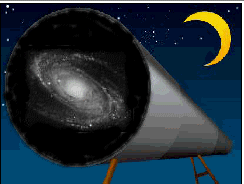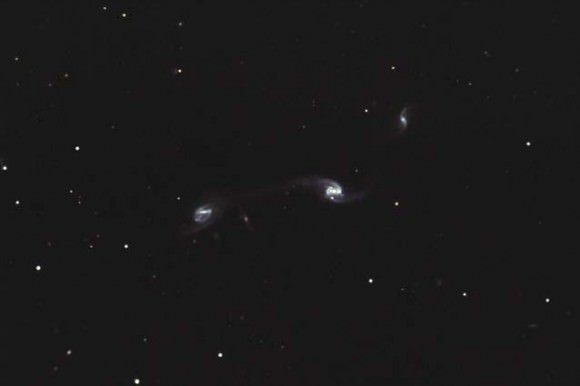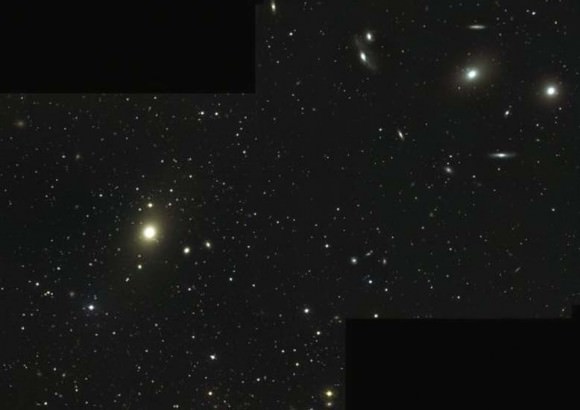Greetings, fellow SkyWatchers! Are you ready for a dark sky observing weekend? Then let’s take a ride with Wild’s Triplets, join Markarian’s Chain gang and hang out with the night Owls. Are you ready? Then grab your telescopes and binoculars and I’ll see you in the backyard….
 Friday, May 22, 2009 – Let’s begin the day by honoring the 1920 birth on this date of Thomas Gold, an astronomer known for proposing the ‘‘steady-state’’ theory of the universe; for explaining pulsars; and for giving the magnetosphere its name. Gold was also an auditory research genius. In his interview with D.T. Kemp he stated:
Friday, May 22, 2009 – Let’s begin the day by honoring the 1920 birth on this date of Thomas Gold, an astronomer known for proposing the ‘‘steady-state’’ theory of the universe; for explaining pulsars; and for giving the magnetosphere its name. Gold was also an auditory research genius. In his interview with D.T. Kemp he stated:
‘‘I’m a compulsive thinker, I never turn my brain off, I’ve never in my life complained of being bored because I’m constantly thinking about some problem, mostly physics I suppose. A problem is always on my mind – evidently even in my sleep because I often wake up with a solution clearly spread out.’’
For the large telescope and seasoned observer, the challenge for this evening will be 5.5 degrees south of Beta Virginis, and one half degree west (RA 11 46 45 Dec -03 50 53). Classified as Arp 248, and more commonly known as ’’Wild’s Triplet,’’ these three very small interacting galaxies are a real treat! Best with around a 9-mm eyepiece, use wide aversion, and try to keep the star just north of the trio at the edge of the field to cut glare. Be sure to mark your Arp Galaxy challenge list!
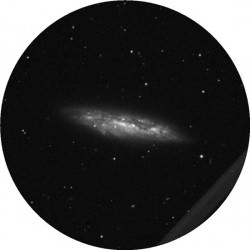 Saturday, May 23, 2009 – Tonight let’s hop to far northern skies for a look at two gems. Start with Beta Ursae Majoris – the southwestern star of the Big Dipper – and begin scanning about a finger-width southeast for M108 (RA 11 11 31 Dec +55 40 31). At magnitude 10, you’ll appreciate this splendid edge-on galaxy! Discovered by Pierre Mechain on February 19, 1781, and later verified by Charles Messier, it didn’t formally enter the Messier’s catalog until 1953 at the hand Owen Gingerich. Despite its low surface brightness, M108 can be spotted by mid-aperture telescopes, and larger scopes will make out irregular patches of detail.
Saturday, May 23, 2009 – Tonight let’s hop to far northern skies for a look at two gems. Start with Beta Ursae Majoris – the southwestern star of the Big Dipper – and begin scanning about a finger-width southeast for M108 (RA 11 11 31 Dec +55 40 31). At magnitude 10, you’ll appreciate this splendid edge-on galaxy! Discovered by Pierre Mechain on February 19, 1781, and later verified by Charles Messier, it didn’t formally enter the Messier’s catalog until 1953 at the hand Owen Gingerich. Despite its low surface brightness, M108 can be spotted by mid-aperture telescopes, and larger scopes will make out irregular patches of detail.
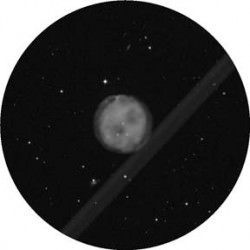 Now, hop on less than a finger-width further southeast (RA 11 14 47 Dec +55 01 08) where you’ll spot M97, the ‘‘Owl Nebula.’’ Discovered by Pierre Mechain 3 days earlier than M108, the Owl is often thought of as one of the most difficult of the Messier studies to detect from urban locations… and it may require a light pollution filter to help bring it to life. About the apparent size of Jupiter, the Owl gets its name from the vague gray-greenness of its light, and the two curious eye-like voids visible through larger scopes. Scientists believe the voids are the result of a line-of-sight phenomenon, where the lowest-density poles lie at an oblique angle from our vantage point. The structure of M97 and its fluorescence are associated with a high surface temperature central star in the last stages of life. Can you spot the faint 16th magnitude dying star at its heart?
Now, hop on less than a finger-width further southeast (RA 11 14 47 Dec +55 01 08) where you’ll spot M97, the ‘‘Owl Nebula.’’ Discovered by Pierre Mechain 3 days earlier than M108, the Owl is often thought of as one of the most difficult of the Messier studies to detect from urban locations… and it may require a light pollution filter to help bring it to life. About the apparent size of Jupiter, the Owl gets its name from the vague gray-greenness of its light, and the two curious eye-like voids visible through larger scopes. Scientists believe the voids are the result of a line-of-sight phenomenon, where the lowest-density poles lie at an oblique angle from our vantage point. The structure of M97 and its fluorescence are associated with a high surface temperature central star in the last stages of life. Can you spot the faint 16th magnitude dying star at its heart?
Sunday, May 24, 2009 – Tonight is the New Moon and time to tour the galaxy fields of Virgo. For large telescopes, this is the ‘‘field of dreams’’… Start four finger-widths east-southeast of Beta Leonis for part of ‘‘ Markarian’s Chain ’’ and discover M84 and M86 (RA 12 25 03 Dec +12 53 13)! Good binoculars and small telescopes reveal the matched ellipticals of M84/86, while mid-sized telescopes will note that western M84 is slightly brighter and smaller. Larger scopes see these two galaxies literally ‘‘leap’’ out of the eyepiece at even modest magnifications!
In large telescopes, the bright galactic forms of M84/86 can be held with direct vision, while aversion welcomes many other mysterious strangers into view. Forming an easy triangle with the two Messiers, and located about 200 south, is 11th magnitude NGC4388, a classic edge-on spiral. Dim NGC4387 (magnitude 12) appears in the center of a triangle as a small face-on spiral with a noticeable dust lane. In large scopes, the central structure forms a curved ‘‘bar’’ of light, and the dust lane cleanly separates the central bulge of the core. East of M86 are two brighter NGC galaxies – 4435 and 4438.
In an average telescope, NGC 4435 has a simple star-like core and wispy round body structure, while NGC 4438 is a dim elliptical. The beauty of the pair is their proximity to each other! At times, a conspicuous wisp of galactic material can be seen stretching back toward the nearby (brighter) galaxy pair M84/86. Happy hunting!
Until next week? “Keep on rockin’ in the free world…”
This week’s awesome images are (in order of appearance): Thomas Gold (historical image), Arp 248: Wild’s Triplet (credit—Adam Block/NOAO/AURA/NSF), M108 and M97 (credit—Palomar Observatory, courtesy of Caltech) and Wide-field image of the Virgo galaxy cluster with M84/86 region to the upper right (credit—NOAO/AURA/NSF). We thank you so much!

